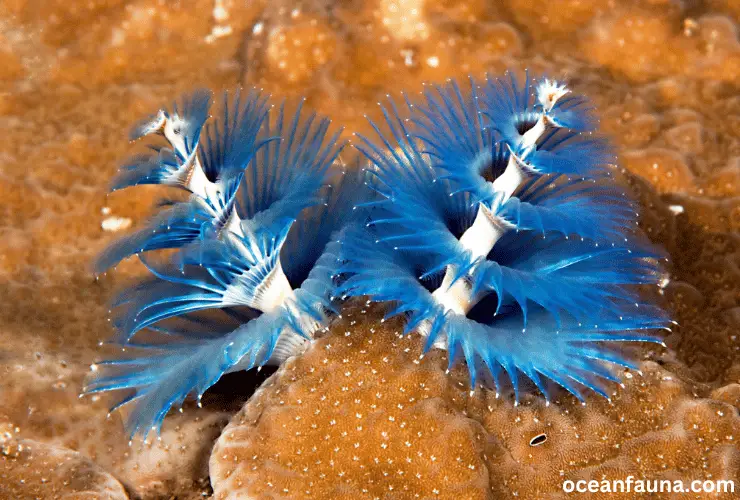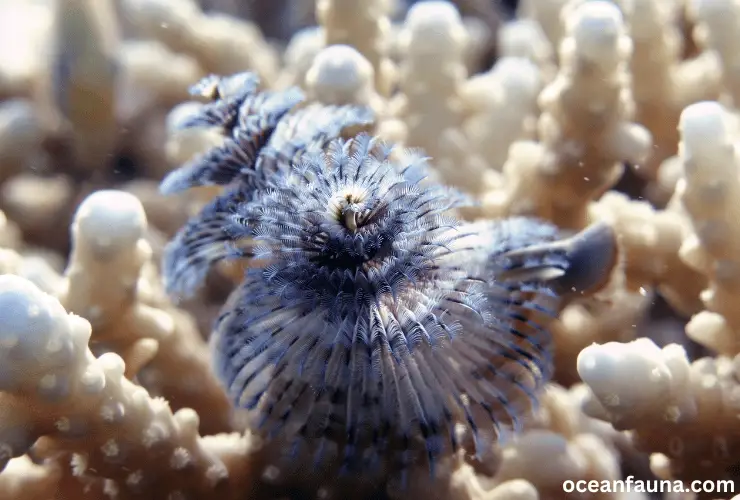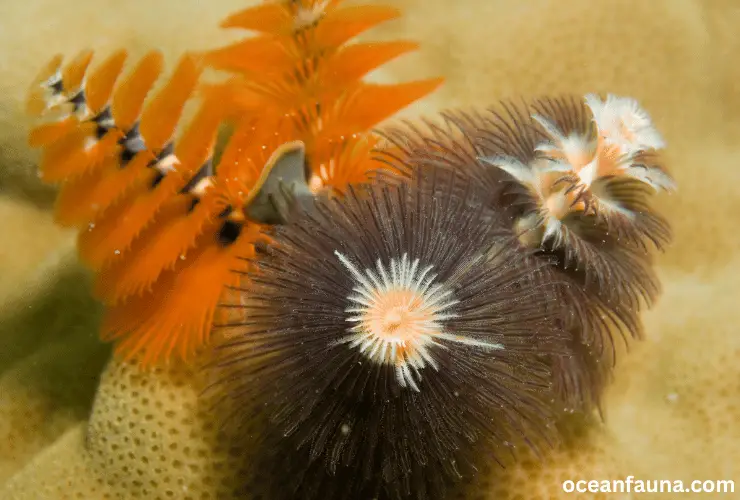The scientific name of the Christmas tree worm is Spirobranchus giganteus. It lies under the polychaete worm that is tube-building. Its family is Serpulidae. Moreover, these little critters are known as the true wonders of the ocean depths. Plus, these marine tube worms are present all over the world in their coral reefs.
Interestingly, the name of Christmas tree worms defines their appearance. They have two spiraled plumes that resemble tiny fir trees. These plumes are specialized structures known as radioles. The worms use the plumes to filter out tiny particles of food from the water. But the magic of these worms doesn’t stop there.
Have you ever encountered these masters of disguise in their natural habitat? Do you feel the need to learn everything there is to know about the enchanted Christmas tree worms? So, let’s take a deep dive into the sea of insights about the crazy facts about Christmas tree worms.

About Christmas Tree Worm – A Quick Biology Table
Take a look at the quick biology facts table here.
| Parameters | Details |
| Scientific name | Spirobranchus giganteus (Pallas, 1766) |
| Kingdom | Animalia |
| Family | Serpulidae |
| Genus | Spirobranchus |
| Class | Pleistoannelida |
| Subclass | Sedentaria |
| Order | Sabellida |
| Phylum | Annelida |
| Species | S. giganteus |
| Geographical range and distribution | Christmas tree worms are distributed in the tropical oceans all over the world. |
| Diet | Zooplankton, phytoplankton, and detritus particles |
| Predators | Fish, sea urchins, crabs, and other crustaceans |
| Size | 1.5 inches in length |
| Weight | Few ounces |
| Lifespan | Over 30 years |
Description and Taxonomy of Christmas Tree Worm
“Christmas Tree Worms” is also known as Spirobranchus giganteus. Here, Spirobranchus means “spiral gills”. It refers to the unique crown of these worms.
They are fascinating creatures that belong to the Animalia kingdom. Basically, they are species of marine tube worms. More interestingly, they are part of the Serpulidae family and the Spirobranchus genus.
Christmas tree worms fall under the Pleisto Annelida class and Sedentaria subclass. They are part of the Sabellida order. The phylum of Christmas Tree Worms is Annelida.
All of these classification terms are helping scientists understand where these worms are fitting in the animal kingdom. This also defines how it is related to other creatures.
ITIS has defined two subspecies of Christmas tree worms. These are S. giganteusa giganteus and S. giganteus corniculatus.

Physical Characteristics of Christmas Tree Worm
The two spiral structures that are typically colored chromatically are what the Christmas tree worms’ Latin and common names allude to. This is the most common feature of these creatures that are observed by divers. These spirals are multicolored.
They are known as highly derived structures that are used for respiration and feeding purposes. Moreover, Christmas tree worms have a resemblance with most of the well-known tube-building polychaetes. These aquatic friends have a tabular body.
The length of their segmented bodies is approximately 1.5 inches (3.8 cm). Chaetae are on their entire bodies. Now you may be wondering what Chaetae is. It’s a tiny appendage that helps the worms move easily.
This is because these Christmas tree worms lack any special appendages to swim and move. So, that’s why they do not stay outside their tubes.
Most Beautiful Feature
The most beautiful and different features of Christmas tree worms are their two crowns, which are shaped just like Christmas trees. These distinctive plumes are actually modified prostomial palps. And the palps are specialized appendages near the mouth used for feeding.
The signature spirals of Christmas tree worms are delicate and feather-like tentacles known as radioles. These structures are covered in tiny, hair-like projections that are called cilia. It helps to move any captured prey toward the mouth of the worm.
These structures are also known as “gills” because these radioles are also used for respiration. Last, but not the least, they have a complete digestive system.
Most Distinctive Features & Colors
Christmas tree worms have a specialized feature as compared to other fan worms of the Sabellida family. Christmas worms have specialized body structures that can plug their tube holes when they retreat into them. This feature sets them apart from their relatives, who lack such relatives.
However, Christmas tree worms have a modified radiole that is commonly known as the operculum. They use them to secure the entrance of their tubes when they withdraw inside. The color of their crowns varies. They are blue, white, orange, red, and yellow.
Cardiovascular and Nervous System of Christmas Tree Worm
Let’s discuss the cardiovascular system and nervous systems of Christmas tree worms in detail:
Cardiovascular system
Christmas tree worms have a well-defined and closed cardiovascular system. It means the blood of these creatures remains closed within blood vessels.
It does not flow freely through their body cavities. They have a heart-like structure commonly known as a “pseudo hemal canal”. It helps pump blood through their system.
Nervous system
The nervous system of a Christmas tree worm is well-developed. It includes a central brain and multiple ganglia. You can also say they have a cluster of nerve cells. The ganglia are located throughout their bodies.
The ganglia help them to coordinate movement and sensory information. Another unique feature of the nervous system is the presence of pedal ganglia. This is mostly found only in the Polychaeta subclass of Annelids.
Despite the smaller size of Christmas tree worms, they have a wonderful ability to sense changes in water temperature, light, and the presence of prey or predator. Overall, their nervous system is well adapted to survive and thrive in the unique ecosystem.
Behaviors of Christmas Tree Worm
Christmas tree worms have a growth behavior. They continuously add new segments to their tubes. This can become quite long over time.
In the corresponding sections on dietary requirements, reproductive systems, and physical characteristics, you can read more about the behaviors of these worms that resemble ornaments.
Feeding Habits/Diet of Christmas Tree Worm
Christmas tree worms consume zooplankton, phytoplankton, organic detritus, and ciliates. These creatures also feed by capturing other food particles with the help of their radioles.
Their mouths receive the food passed by the heavily-ciliated radioles. It shows they use filter-feeding methods for the consumption of food and radioles do this job for them.

Habitat, Range, and Geographical Distribution of Christmas Tree Worm
Let’s see what Marine Species organization writers have investigated about the habitat and range of the Christmas Tree Worms:
“Christmas tree worms are found all over the world in the tropical oceans. They are widely distributed there. Plus, these sea creatures are known to be distributed from the Indo-Pacific oceans to the Caribbean, including the Red Sea and the Great Barrier Reef.
Christmas tree worms are sedentary creatures. They are highly dependent on their environment. Moreover, they require a healthy and stable coral reef habitat to survive. Their geographical range is largely dependent on the distribution of their preferred coral reef habitats.
Christmas tree worms are typically found at depths of up to 60 to 100 feet (18 meters). They prefer to live in clear, warm water with low to moderate currents. They are abundantly found in the Gulf of Mexico. There, they thrive in the warm and nutrient-rich waters.
Christmas tree worms can easily be seen in seagrass beds and other hard substrates. They are a popular sight for divers and snorkelers from Indonesia and the Philippines to Australia and French Polynesia in the Pacific Ocean. They can also be found in the Indian Ocean, particularly along the coast of East Africa and the Red Sea.
Reproduction system of Christmas Tree Worm
According to the writers of the American Oceans organization, the Christmas tree worms are broadcast spawners. The female worms release eggs in the water. Then, the male worms release sperm into the water for fertilization/reproduction.
The abdominal segments of Christmas tree worms can produce gametes. Also, the fertilization of the eggs occurs externally to the female tree worm.
The fertilized eggs mature into larvae within a day. These eggs then float with the zooplankton for about 9 to 12 days while growing. The larvae of tree worms then settle on a piece of coral after drifting for several days.
The Christmas tree worms create a tube made of mucus that hardens into calcareous material. It leads to the formation of their distinctive calcareous tube structure. The structure then transforms into Christmas tree worms.
The Lifespan of Christmas Tree Worm
According to the study, the lifespan of Christmas Tree Worms varies. They can live 10 years sometimes and they can also live 40 years sometimes. Thus, their average lifespan is between 10 to 40 years.
The growth rate of Christmas tree worms is slow compared to other marine creatures. Some individuals take up to two years to reach their full size. So, we had come to know that their slow growth rate and long lifespan make them vulnerable to environmental threats.
Important note: Soft X-rays are an application used to find the correct age of Christmas tree worms.
Possible Hazards and Threats
Here are a few possible threats and hazards to Christmas tree worms:
- Human threats: Christmas tree worms are not captured for food. They are harvested for trading in aquariums. They are shy and don’t come out of the coral without any reason. So, impatient divers try to disturb them from coming out. This is a threat to these worms as they feel harm.
- Global warming and climate change: Climate change due to global warming is a major threat to the health of the Christmas tree worms. Seawater acidification due to carbon emissions has made it challenging for them to reproduce and construct calcareous tubes. Degraded marine environments can negatively affect coral reefs. These unstable reefs can threaten the well-being of Christmas tree worms. Christmas worms have the ability to push away the starfish that destroys corals. These worms help the corals to recover faster.
- Sedimentation: Last but not least, sedimentation is another possible threat to these marine worms. Basically, sedimentation can smother coral reefs and reduce the amount of light reaching them. This makes it difficult for the zooplankton to photosynthesize. It might then cause coral death. As predators are also harmful to these worms, you can read about another threat posed by Christmas tree worms in the section on predators.
Ecology
The stony corals that are significant ecologically in this area are Porites and Brain corals. The Christmas tree worms are usually found living entirely within the heads of these massive corals. These worms have the ability to produce a hard and calcareous tube that surrounds their bodies. But why is it important?
This tube is important because it serves as a protection and a home for S. giganteus. Christmas tree worms typically choose a living coral head to attach themselves to when settling into their new homes. They then begin secreting their calcareous tube. This offers an additional layer of protection. ~ source
The coral tissue will grow over the tube as time passes. It further increases the level of security and safety of the worms. Additionally, the way they secure their tube when retreating inside is very distinctive. They use an operculum to seal the opening. This is then reinforced with sharp and antlers-shaped spines for added protection.
According to the NCBI research article, we found the following facts:
“Christmas tree worms mainly rely on filter feeding as their primary method of obtaining food. It is because they are stationary residents of coral reefs. They filter small organisms (typically microorganisms) from the surrounding water using their vivid and colorful radioles. In order to be digested, these microorganisms are then delivered right to the worms’ digestive system.
According to these NCBI researchers, there are only a handful of known organisms that prey on tube-dwelling polychaetes. Christmas tree worms are no different here. The exact symbiotic relationship between Christmas tree worms and their coral hosts is not yet fully understood.
However, the researchers observed that the movement of the operculum of the worm can sometimes cause serious damage to the coral tissue. Additionally, the risk of coral tissue mortality increases when the operculum becomes host to the filamentous algae.
Economic Importance of Christmas Tree Worm
Christmas tree worms do not have much economic importance. They are not used as food nor do they have any medical value. They are only economically important for adding enthusiasm to the aquariums of aquarists.
They can add visual interest and help to aerate the substrate. The aquarium trade for marine ornamental species is a multi-million dollar industry all over the world.
Predators of Christmas Tree Worm
The common predators of Christmas tree worms are crabs, shrimp, gastropods, and sea urchins. Butterfish is known as a tropical reef fish that also eats these worms. Some other fish species, like wrasses, pufferfish, and triggerfish, also feed on them.
Usually, these predators prefer to eat only plumes. Their remaining parts will regrow automatically after a few weeks. Additionally, some species of polychaete worms are also observed preying on these worms.
Relationship with Humans / Importance to Humans
The Christmas tree worms are not commercially harvested. They, therefore, don’t matter in terms of commercial fishing. However, divers and marine aquarists have an interest in these aquatic worms. They are generally appreciated for their colorful and distinctive appearance.
In some places, like the Caribbean, they are considered a tourist attraction. Their colorful crowns make them a highly sought-after subject for underwater photographers among sports divers. Moreover, many aquarists intentionally include coral heads inhabited by Christmas tree worms in their miniature reef tanks.
Conservation Status and Population
We have mentioned before that these species are distributed widely, and that their conservation status has never been evaluated. Even polychaetes are not endangered or rare. Let’s see what the SpringerLink journal article is saying about its conservation and distribution status:
Christmas tree worms were initially believed to be found only in coral heads.” However, a recent study has discovered them living as epibionts on Tridacna squamosa, which is a species of giant clam. This finding was reported in the Gulf of Thailand.”
So, the host species that Christmas tree worms live on have varying conservation statuses. However, their population is stable.
Communication Method of Christmas Tree Worm
Christmas tree worms do not communicate like humans or marine creatures. They lack any vocal system. However, they use brightly colored radioles as a visual signaling way to attract mates. They also warn off predators with the help of their radioles.
FAQs
Are Christmas tree worms poisonous?
No. Christmas tree worms are not poisonous. However, it is important to handle them with care and respect in their natural environment.
What’s the speed of a Christmas tree worm?
Christmas tree worms do not have a measurable speed; as we have mentioned before, they do not move.
Is the Christmas tree worm dangerous?
No. Christmas tree worms are not dangerous to humans or any other marine creature. They are not venomous, nor do they have any harmful effects on humans. They are completely harmless. Lastly, they are safe to observe in their natural habitat.
What do the Christmas tree worms do?
The Christmas tree worms do not do much. They are stationary creatures. When they find a peaceful location that they like, they tend to stay there and do not move much.
Conclusion
Christmas tree worms are fascinating creatures with their festive and colorful appearance. They are adding a special charm to the underwater world. These bright and brisk worms are peaceful marine creatures. Let’s not threaten them and let them live in their homes. So, they will continue to thrive and spread joy in the oceans!
I hope you enjoyed reading this informative article. If you have any questions, you can ask them in the comments section. We would be happy to answer all of your queries!
